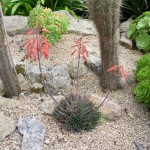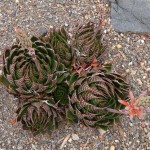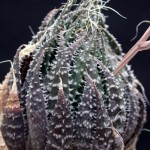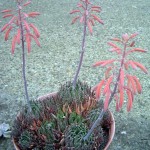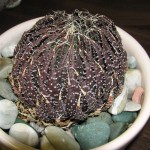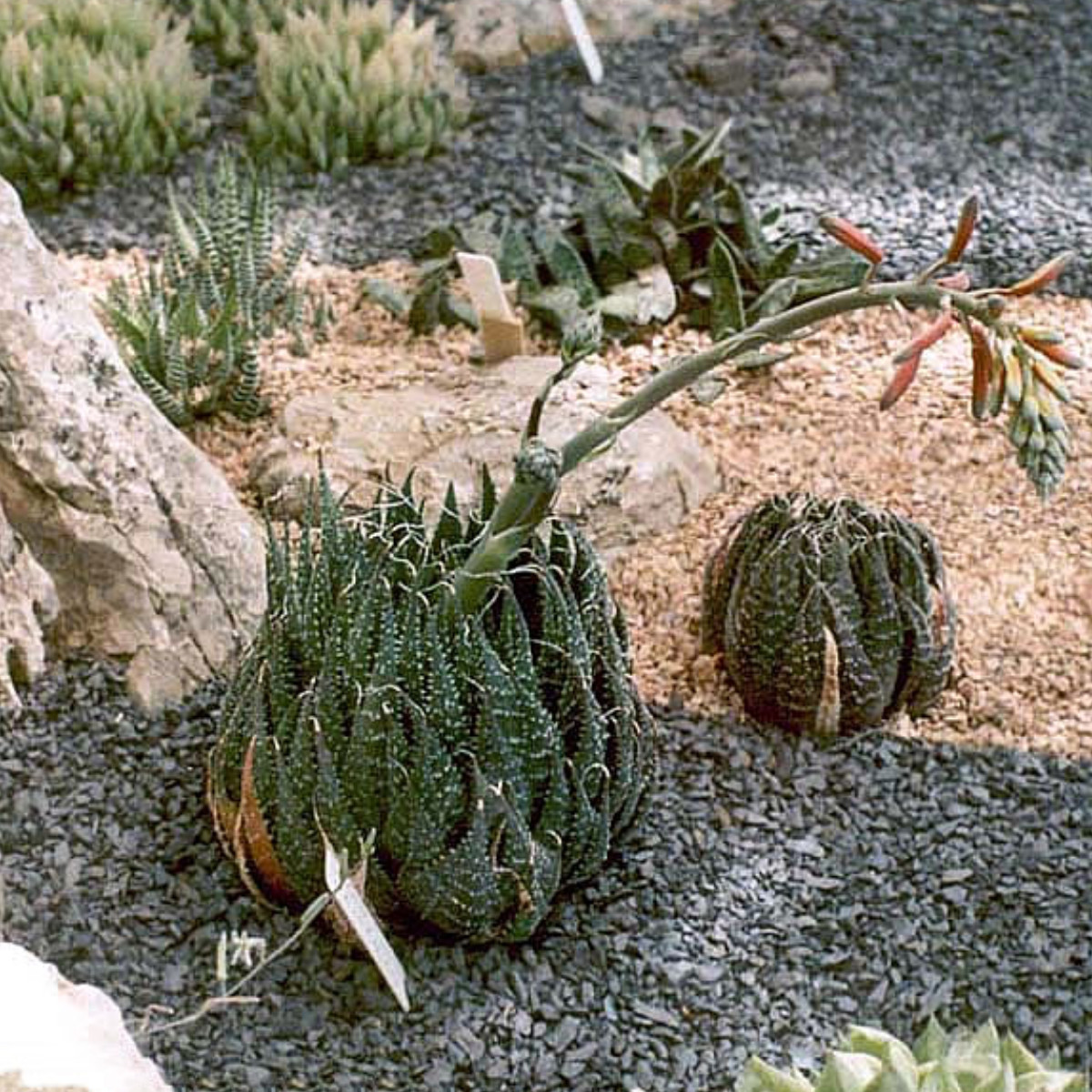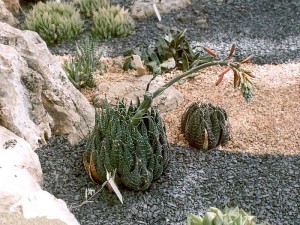Family: Xanthorrhoeaceae
Subfamily: Asphodeloideae
Synonymous: Aloe ellenbergeri
Aloe longiaristata
Distribution and habitat: Aloe aristata is a species of evergreen flowering perennial plant in the subfamily Asphodelaceae. It is native to mountains grassland of South Africa and is therefore best suited to warm, dry conditions. These plants can be found growing up to 2300m (7500 feet) above sea level in their natural habitat and is one of the hardest species within its genus. They have become increasingly rare in the wild through harvesting.
Description: Aloe aristata is a dwarf version of the Aloe genus. It is stemless with dark grey-green leaves densely packed in a rosette. Each leaf is about 15cm (6 inch) long and 2cm (0.8 inch) wide, spotted with tubercles. The margins of the leaves are lined with white horny materials and both the margins and the surfaces of the leaves are minutely toothed with short, soft white spines.
and has hard white edges and a bristle like growth from the leaf tip. Orange flowers, which appear on a 30cm (12 inch) stalk in early summer, lasting for several days. Mature plants produce many offsets.
Its fleshy leaves retain water allowing the plant to get through periods of drought without trouble. It is a small plant, usually growing to about 15 to 20cm (6-8 inch) in a tight rosette formation. Its nectar-rich, tubular orange flowers attract birds and bees.
Houseplant care: Aloe aristata is a small hardy succulent plant popular as an indoor plant.
Light: Bright light suits Aloe aristata. It will not thrive if permanently placed at a distance from a window.
Temperature: Aloe aristata plants grow well in normal room temperatures and are tolerant of dry air. To encourage flowering, however, it is best to give the plants a short winter rest at a temperature of no more that 10C (50F).
Watering: During the active growth period water plentifully as often as necessary to keep the potting mixture thoroughly moist. During the rest period water only enough to prevent the potting mixture from drying out. Do not permit water to collect in the tight rosette.
Feeding: Apply standard liquid fertiliser every two weeks during the active growth period.
Potting and repotting: Use a soil based potting mixture. Most Aloe aristata should be moved into pots one size larger every spring. Keep these plants in shallow pots. When maximum convenient pot size has been reached, plants should be top dressed with fresh potting mixture once a year. To prevent rot, make sure that these plants which have tick basal leaves are never buried deeper than they were before. A sprinkling of coarse sand over the surface of the potting mixture helps to prevent rot points where fleshy leaves of these stemless plants touch the soil.
Gardening: In order to grow Aloe aristata in temperate climates they will need to be taken inside during the coldest weather and keep them in bright sunlight during the summer. This species is hardier than many other species within its genus, but will still appreciate the warmth. It requires very little maintenance, making it an ideal choice for novice gardeners.They flower freely in the summer and the soft-orange flowers are a wonderful addition to the arid garden.
Location: Aloe aristata can be place in full sun or semi-shade in hot climates.
Soil: Dry and well drained gritty soils are suitable for these plants. Sandy free draining soil will keep the Aloe aristata healthy. Use cactus compost or add sand to improve the garden soil drainage.
Irrigation: This genus is well known for its ease of cultivation, but they are sensitive to excessive irrigation. Provide regular watering in spring and summer to make the soilthoroughly moist then allow the soil to dry before watering again. In winter (during the dormant season) water sparingly or not at all, as it is prone to rotting; a thin layer of gravel on top of the soil will help to prevent this.
Fertilising: Feed Aloe aristata very little now and then during the active growth period.
Propagation: Aloe aristata produces offsets that can be taken from the base of a plant early in summer. These small new rosettes are often attached to the parent by a short underground stolon and may already have little roots, which should be retained for propagation propose.
Because very tiny offsets are hard to root, they should not be removed for planting until their leaves have begun to open into the characteristic rosette shape.
Offsets will root in two to three weeks in the standard potting mixture if some coarse sand is sprinkled at the base of the rosette to prevent rotting. Until offsets are well established, they should be provided with bright light without direct sunlight and they should be watered only enough to moisten the potting mixture, allowing the top two-thirds of the potting mixture to dry out between waterings.
Also, Aloe aristata can be propagated by seed sown in warm environment as soon as ripe.
Problems: Most likely to be caused by incorrect watering. A properly watered Aloe aristata plant can resist most pests and diseases.
Wilting is the result of inadequate water in summer.
Yellowing leaves accompanied by rotting at the base is the result of overwatering plants kept in cool winter conditions.
Mealy bugs and root mealy bugs ca be troublesome. The former hide deep in the crevices of rosette foliage and the latter generally bury themselves in the roots, just below the surface of the potting mixture.
Treatment: Remove visible bugs with a toothpick or a damp cloth or swab them off foliage with a small, stiff paintbrush dipped in methylated spirit or an insecticide solution. Then spray all top growth with an appropriate pesticide. Alternatively, place granules of a systemic pesticide in the potting mixture. During the next month examine plants weekly for traces of reinfestation.
Scale insects can also infest this plant.
Treatment: Scale can be easily controlled by physical removal, wash off with high pressure jet of water or scrape off with cotton wool buds or by chemical control with appropriate pesticide.
Note: When not in bloom,Aloe aristata is similar to and often confused with Haworthia fasciata.
Uses:Aloe aristata is cultivated as a garden plant, but as it requires winter protection is grown under glass in temperate regions. Left to grow by themselves, they quickly form a large clump and are very effective in a large xeriphytic landscape if planted en masse about 0.5m (2 feet) apart, so that as the clumps grow and spread they form an expansive globular carpet.
Also, Aloe aristata is often grown indoors as a window-ledge succulent plant.
SUMMARY:
CHARACTERISTICS:
Foliage variegated
Features flowers
Shape rosette
Height: 15 to 20cm (6-8 inch)
PROPER CARE:
Watering in rest period sparingly
Watering in active growth period plentifully
Light bright filtered
Temperature in rest period min 7C max 10C (45-50F)
Temperature in active growth period min 16C max 24C (61-75F)
Humidity low
Hardiness zone: 7b-11
